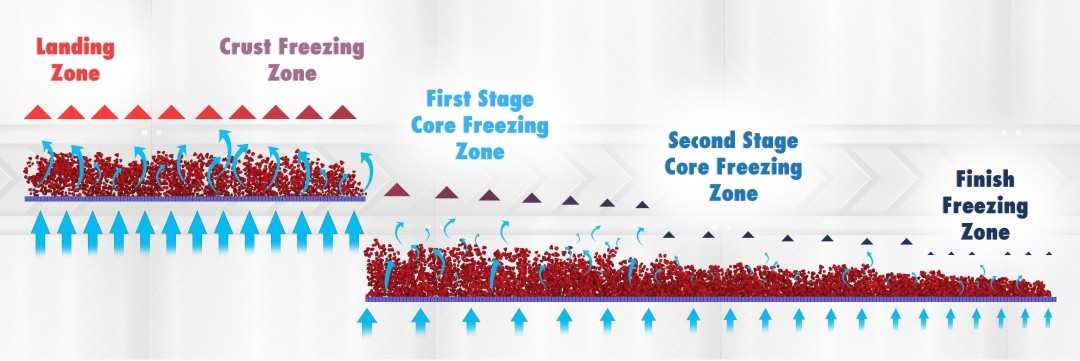
ALL YOU NEED TO KNOW ABOUT FLUIDIZATION IN IQF FREEZING
If in general terms Fluidization is a process similar to liquefaction during which a granular material is converted from a static or solid state to a dynamic or fluid state, in IQF the fluidization term is referred to as the ability of the product to act as a liquid due to the influence of airstreams, continuously moving and advancing inside the freezer at the feeding rate.
SO WHY IS IT IMPORTANT TO
TALK ABOUT FLUIDIZATION?
Fluidization is what makes the products separate from each other and individually freeze. The truth is, fluidization needs not only to be mentioned and defined but closely studied and perfected and here is why. By learning how to juggle with the fluidization of the product during IQF freezing, the processors can use the most suitable type of fluidization for each individual product type. It is of course logical that a heavy product such as diced mango doesn’t need the same type of fluidization like chopped basilica for instance. Based on the characteristics of the product such as water content, shape, weight, brix level, fragility - the processors have the mission to adjust the fluidization in such a way – to obtain the best-looking, perfectly separated frozen product.
3 MAIN TYPES OF FLUIDIZATION
IN IQF FREEZING
There are 3 main types of fluidization recognized in the IQF industry and which are used in different parts of the freezer, and namely: circulating fluidization, bubbling fluidization and fixed bed fluidization. In short, the circulating fluidization is used to completely lift the product from the bed under strong, cold airstreams and its usually used in the first part of the freezer for crust-freezing when the product is still warm and wet. The bubbling fluidization is a milder version of the previous type and it only partially lifts the product (hence the name of semi-fluidized bed) – usually used on the second bed the already crust-frozen product acts as a boiling liquid. And finally, the fixed bed fluidization – used to finish-freeze the product in the last part of the IQF tunnel, the product is mostly resting on the bed, also suitable for very fragile products. There can of course be variations of these 3 types.
THE ART OF ACHIEVING
THE RIGHT FLUIDIZATION: CHOOSE YOUR FANS
A few important elements of the IQF freezer which play a crucial role in the creation of fluidization in each part of the IQF tunnel are: the type of fans, the design of the bed and overall design of the freezer body.
The design of the fans is a very important aspect to keep in mind. Not all type of fans can contribute to the creation of the right fluidization you might need. For instance, the OctoFrost™ fans which are vane axial fans, created and modified specifically for the OctoFrost™ freezer made it possible to install and efficiently use frequency converters. This means that the airflow can be increased or decreased depending on the fluidization type the processor is aiming to achieve. IQF freezers which do not have this option must bypass or hinder the unnecessary, extra air current. This means that part of electricity consumed by the tunnel and the refrigeration plant is a waste and this many times affects the profitability of the business.
WITH THE RIGHT BEDPLATE
COMES THE RIGHT PRESSURE DROP
The pressure drop achieved on the bed – another very important influential factor – not only depends on the airflow generated by the fans but also depends on the design of the bed and specifically the size and distribution of holes through the bed. The OctoFrost™ bedplates have been designed thicker than any other bedplate on the market to allow bigger holes in the bedplate which results in a higher pressure-drop – a crucial precondition for a uniform and good fluidization. In addition, as the size of each hole determines the speed of the air passing through it, the diameters in the bedplates are decreasing towards the outfeed following the changing characteristics of the product. This configuration has been carefully calculated to create a specific airspeed in the holes and an even distribution of the airflow.
IT'S ALL ABOUT AERODYNAMICS
And finally, the overall design of the freezer body, directly influences the aerodynamics of the system and therefore the degree of control over the fluidization. This is the reason why OctoFrost has designed a compact freezer body with minimum details which might hinder or obstruct the airflow and therefore makes it easier to control and customize the fluidization for each type of product.
Yet again, we learn that IQF technology is a fine art, based on pure science, and OctoFrost is committed to master it.
